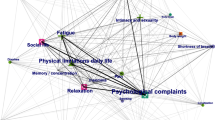Abstract
Cancer patients experience many symptoms throughout their cancer treatment and sometimes suffer from lasting effects post-treatment. Patient-Reported Outcome (PRO) surveys provide a means for monitoring the patient’s symptoms during and after treatment. Symptom cluster (SC) research seeks to understand these symptoms and their relationships to define new treatment and disease management methods to improve patient’s quality of life. This paper introduces association rule mining (ARM) as a novel alternative for identifying symptom clusters. We compare the results to prior research and find that while some of the SCs are similar, ARM uncovers more nuanced relationships between symptoms such as anchor symptoms that serve as connections between interference and cancer-specific symptoms.
Access this chapter
Tax calculation will be finalised at checkout
Purchases are for personal use only
Similar content being viewed by others
References
Christopherson, K.M., et al.: Chronic radiation-associated dysphagia in oropharyngeal cancer survivors. Clinic. Transl. Rad. Oncology 18, 16–22 (2019)
Wentzel, A., et al.: Precision toxicity correlates of tumor spatial proximity to organs at risk in cancer patients. Radiother. Oncol. 148, 245–251 (2020)
Wentzel, A., et al.: Cohort-based T-SSIM visual computing for radiation therapy prediction and exploration. IEEE Trans. Vis. Comp. Graph. 26(1), 949–959 (2019)
Marai, G.E., et al.: Precision risk analysis of cancer therapy with interactive nomograms and survival plots. IEEE Trans. Vis. Comp. Graph. 25(4), 1732–1745 (2018)
Sheu, T., et al.: Conditional survival analysis of patients with locally advanced laryngeal cancer. Sci. Rep. 7, 43928 (2017)
Miaskowski, C., et al.: Advancing symptom science through symptom cluster research. J. Nat. Cancer Instit. 109(4) (2017)
Cleeland, C., et al.: Assessing symptom distress in cancer patients: the M.D. Anderson Symptom Inventory. Cancer 89, 1634–46 (2000)
Rosenthal, D.I., et al.: Measuring head and neck cancer symptom burden. Head Neck J. Sci. Specialt. 29(10), 923–931 (2007)
Skerman, H.M., et al.: Multivariate methods to identify cancer-related symptom clusters. Res. Nurs. Health 32(3), 345–360 (2009)
Rosenthal, D.I., et al.: Patterns of symptom burden during radiotherapy or concurrent chemoradiotherapy for H&N cancer. Cancer 120(13), 1975–1984 (2014)
Agrawal, R., Srikant, R., et al.: Fast algorithms for mining association rules. In: Proceedings 20th International Conference on Very Large Data Bases, VLDB, vol. 1215, pp. 487–499 (1994)
Kirkova, J., Aktas, A., Walsh, D., Davis, M.P.: Cancer symptom clusters: clinical and research methodology. J. Palliat. Med. 14(10), 1149–1166 (2011)
Hahsler, M.: arulesviz: interactive visualization of association rules with r. R J. 9(2), 163 (2017)
Tosado, J., et al.: Clustering of largely right-censored oropharyngeal HNC patients to improve outcome prediction. Sci. Rep. 10(1), 1–14 (2020)
Luciani, T., et al.: A spatial neighborhood methodology for computing & analyzing lymph node carcinoma similarity in precision medicine. J. Biomed. Info. 5 (2020)
Author information
Authors and Affiliations
Corresponding authors
Editor information
Editors and Affiliations
Rights and permissions
Copyright information
© 2021 Springer Nature Switzerland AG
About this paper
Cite this paper
Biggs, M. et al. (2021). Identifying Symptom Clusters Through Association Rule Mining. In: Tucker, A., Henriques Abreu, P., Cardoso, J., Pereira Rodrigues, P., Riaño, D. (eds) Artificial Intelligence in Medicine. AIME 2021. Lecture Notes in Computer Science(), vol 12721. Springer, Cham. https://doi.org/10.1007/978-3-030-77211-6_58
Download citation
DOI: https://doi.org/10.1007/978-3-030-77211-6_58
Published:
Publisher Name: Springer, Cham
Print ISBN: 978-3-030-77210-9
Online ISBN: 978-3-030-77211-6
eBook Packages: Computer ScienceComputer Science (R0)




